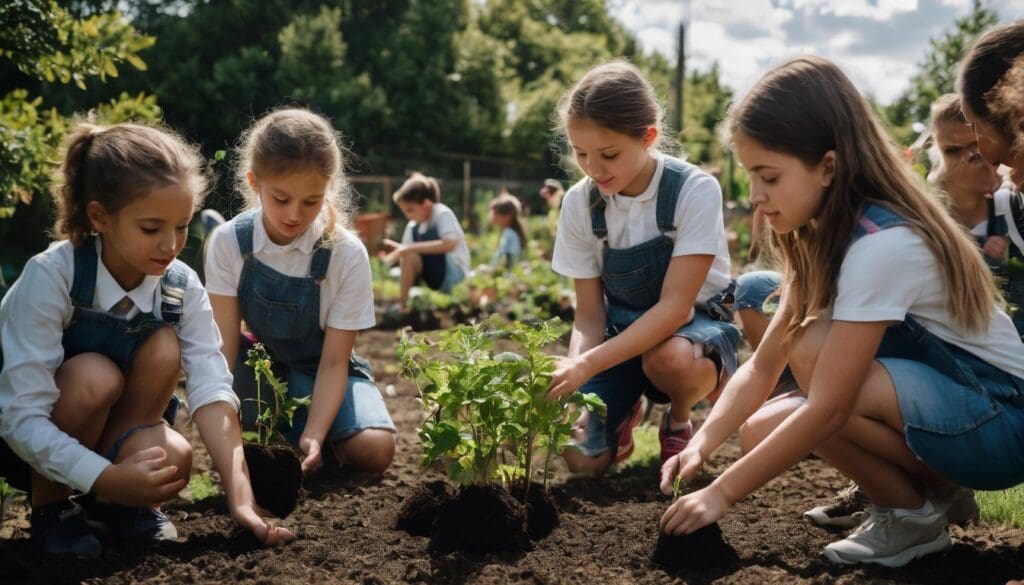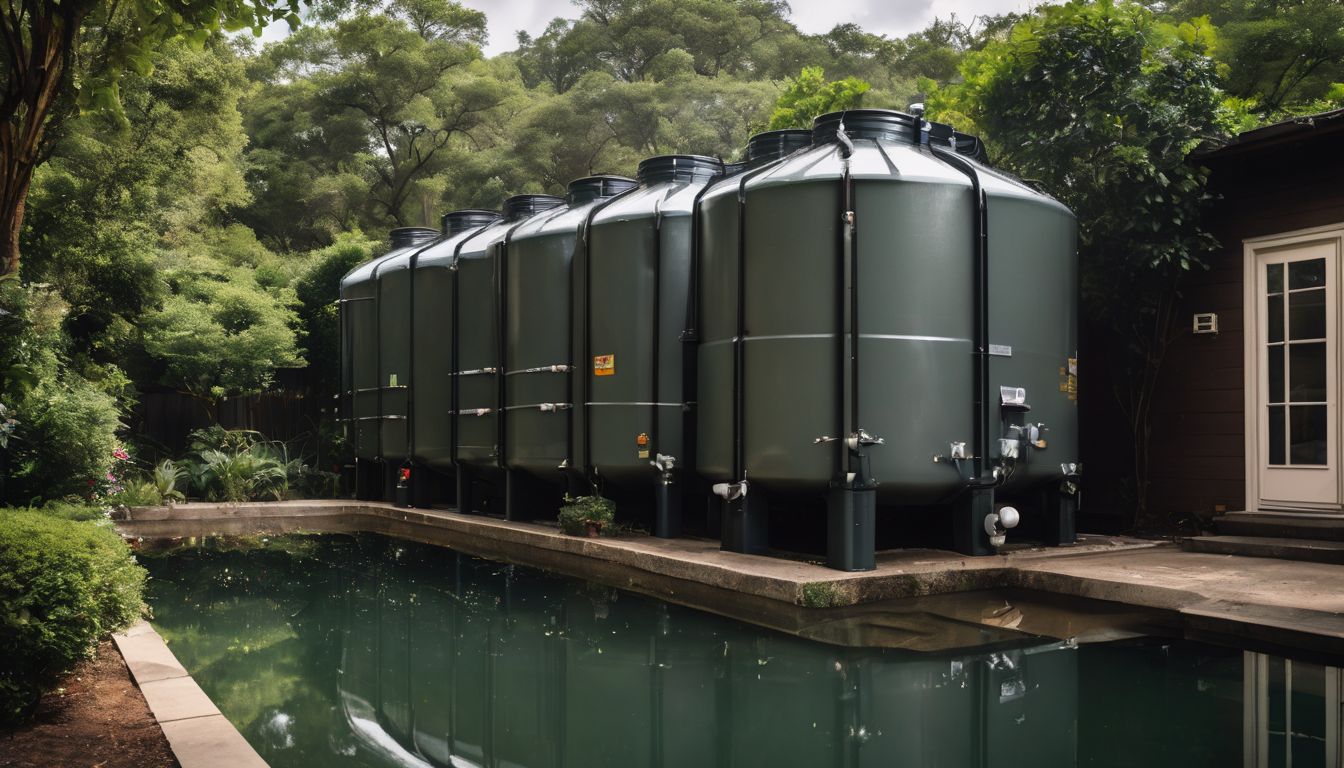Many of us worry about the health of our planet. Schools are ideal places to start making a difference, as they’re hubs for learning and community spirit. This article will show you practical ways that local schools can lead in environmental projects, helping both students and communities go green together.
Let’s dig in and plant the seeds for a better future!
Key Takeaways
- Local schools are central to fostering sustainability and responsibility by teaching students about environmental issues through hands-on projects like school gardens or recycling programmes.
- Projects that engage both students and community members help build a strong network of support for eco-friendly initiatives, creating a shared sense of purpose and collaborative spirit in tackling local environmental challenges.
- Student – led initiatives within schools empower young people to take ownership of sustainability issues, leading to meaningful action and the development of lifelong environmentally conscious attitudes.
- Schools serve as platforms for community engagement in environmental education, allowing for real-world learning experiences that encourage active participation from families and other community members in conservation efforts.
- By partnering with local organisations and integrating environmental curriculum into everyday learning, schools can inspire future generations to advocate for positive change within their communities, ensuring a greener tomorrow.
The Importance of Engaging Local Communities in Environmental Projects
Engaging local communities in environmental projects is crucial for building a sense of community, educating students and community members, and promoting environmental stewardship.
This involvement creates a ripple effect that can lead to positive change and sustainable action within the community.
Building a sense of community
Building a sense of community starts with bringing people together around a common purpose. Environmental projects offer this unique opportunity, fostering teamwork and shared goals among students, teachers, and local residents.
By tackling environmental issues head-on, schools become the heart of sustainable action, drawing in volunteers eager to make a difference. This collective effort not only beautifies neighbourhoods but also strengthens ties between diverse groups within the community.
In every green school project or eco-friendly initiative, there’s a chance for everyone to contribute their skills and ideas. Students learn leadership as they drive stewardship projects; parents offer hands-on support; local businesses provide resources; all weaving into the vibrant tapestry of an involved community.
Service learning becomes more than just an educational buzzword—it transforms into real-world impact that galvanises an entire town or city towards better environmental practices and awareness raising about crucial ecological matters.
Educating students and community members
To further cultivate a sense of community, engaging local schools in environmental projects plays a crucial role in educating students and community members. By integrating environmental education into school curriculums, students can develop a deep understanding of ecological challenges and the importance of sustainable practices.
Through interactive workshops, eco-friendly initiatives, and practical learning experiences, students become empowered to take meaningful action in their communities.
Encouraging community members to participate in educational programs and stewardship projects fosters a culture of environmental awareness. As schools serve as hubs for knowledge dissemination, involving local communities creates an inclusive environment where individuals learn from each other’s experiences and collaborate towards shared sustainability goals.
Promoting environmental stewardship
Promoting environmental stewardship involves encouraging individuals and communities to take responsibility for conserving the environment. By engaging local schools in environmental projects, we can instill a sense of ownership and accountability in students, promoting sustainable actions and eco-friendly initiatives.
Encouraging student participation in sustainability projects helps foster a culture of environmental activism within the community, creating a more sustainable future for all.
Through community involvement in environmental education, schools can lead by example, demonstrating environmentally conscious practices and inspiring students to become stewards of the environment.
The Role of Schools in Environmental Education
Schools play a vital role in shaping the environmental values and behaviours of students. They provide a platform for community engagement through hands-on learning opportunities, instilling stewardship and responsibility for the environment in future generations.
Instilling environmental values in students
Schools play a vital role in instilling environmental values in students. Incorporating sustainability into the curriculum encourages eco-friendly behaviors. Engaging students in green projects fosters a sense of responsibility for the environment and promotes active stewardship within local communities – key elements to build a sustainable future.
Encouraging student-led initiatives boosts their ownership of environmental issues, leading to meaningful action. Through hands-on experiences, students gain a deep understanding of environmental challenges and develop the skills needed to address them effectively.
This approach sparks lifelong environmentally conscious attitudes, shaping future leaders committed to preserving our planet.
Creating a platform for community engagement
Schools play a pivotal role in creating a platform for community engagement in environmental projects. By involving students, teachers, and parents, schools become hubs for fostering collaborative efforts to address local environmental issues.
Students can take part in initiatives such as eco-friendly campaigns, waste reduction drives, and tree-planting activities; thereby encouraging wider community involvement.
Engaging local schools in sustainability projects cultivates a sense of collective responsibility within the community. Schools can organise events like eco-audits or green expos that involve various stakeholders and highlight the positive impact of these actions on the environment.
Providing hands-on learning opportunities
Creating a platform for community engagement sets the stage for hands-on learning opportunities, allowing students to develop practical skills and a deeper understanding of environmental issues. By engaging in hands-on projects, students can actively contribute to their local environment while gaining valuable experience. Here are some ways to provide hands-on learning opportunities:
- Organise field trips to local parks or conservation areas, where students can participate in activities such as tree planting, wildlife observation, or clean-up initiatives.
- Collaborate with local environmental organisations to offer workshops or training sessions on topics like composting, recycling, or sustainable gardening.
- Establish a school garden or greenhouse to teach students about food production, biodiversity, and the importance of sustainable agriculture.
- Implement citizen science projects that enable students to collect and analyse data related to local environmental issues, contributing to real scientific research.
- Create opportunities for hands-on experimentation through science-based projects that focus on topics like water quality testing, air pollution monitoring, or renewable energy technologies.
Ways to Engage Local Schools in Environmental Projects
Partner with local schools, incorporate environmental curriculum into school programs and support student-led initiatives to create meaningful and impactful environmental projects in the community.
Discover more ways to engage local schools in environmental projects by reading the full blog.
Partnering with schools
Engaging local schools in environmental projects is essential for fostering a culture of sustainability. Collaborating with schools provides opportunities to integrate environmental education into the curriculum, encouraging students to take an active role in conservation efforts.
By partnering with schools, communities can support student-led initiatives, such as eco-friendly events and projects that address local environmental issues. This collaboration not only empowers young individuals to become environmentally conscious citizens but also strengthens the bond between schools and their surrounding communities, leading to a more sustainable future for all.
Moving forward, let’s explore innovative ways to incorporate environmental curriculum into school programmes.
Incorporating environmental curriculum into school programs
Schools play a critical role in educating students about environmental issues. By incorporating environmental curriculum into school programs, students can gain a deeper understanding of sustainability and conservation.
This can be achieved through interactive lessons, outdoor activities, and project-based learning that promote eco-friendly practices. Students benefit from hands-on experiences that foster a sense of responsibility towards the environment.
Incorporating environmental curriculum into school programs provides an opportunity to instill values of stewardship and sustainability in the next generation. It also encourages students to take action on local environmental challenges and empowers them to become advocates for positive change within their communities.
Supporting student-led initiatives
Schools can empower students to take charge of environmental projects. Encouraging student-led initiatives fosters a sense of ownership and responsibility, nurturing future environmental leaders.
By supporting student-driven stewardship projects, schools instill a deep connection to sustainable action and community involvement in eco-friendly initiatives. Engaging students in sustainability projects promotes education and awareness through hands-on environmental activities, creating a lasting impact on local communities.
Empowering young individuals to champion eco-friendly initiatives within their schools supports conservation efforts and encourages active participation in addressing community issues.
Benefits of Engaging Local Schools in Environmental Projects
Engaging local schools in environmental projects creates a more sustainable community and fosters a sense of responsibility and ownership. It also builds stronger relationships between schools and communities.
Creating a more sustainable community
Local schools play a vital role in creating a more sustainable community by educating students about environmental stewardship and fostering a sense of responsibility. By engaging with schools on eco-friendly initiatives, communities can build stronger relationships and instill the values of sustainability in future generations.
Involving local schools in environmental projects not only promotes awareness but also encourages action towards addressing community issues, ultimately contributing to a more environmentally conscious and responsible society.
Supporting sustainability projects in schools is essential for nurturing student-driven stewardship projects that address local environmental concerns. Through hands-on learning opportunities and service learning in environmental projects, students are empowered to take an active role in promoting eco-friendly practices within their communities.
Fostering a sense of responsibility and ownership
By creating a more sustainable community, local schools play a crucial role in fostering a sense of responsibility and ownership among students. Engaging students in environmental projects instils a deep understanding of the impact their actions have on the community and the environment.
Through hands-on involvement in sustainability initiatives, high school students can take ownership of their role as stewards of the environment, contributing to long-term conservation efforts and building valuable skills for addressing future environmental challenges within their communities.
Supporting student-driven stewardship projects further promotes a sense of responsibility and ownership. By empowering young individuals to take meaningful action, schools can cultivate an ethos of proactive engagement with local environmental issues.
Building stronger relationships between schools and communities
Engaging local schools in environmental projects can help build stronger relationships between schools and communities. Through collaborative efforts, students, teachers, and community members work together towards a common goal of sustainability.
By involving local schools in environmental initiatives, a sense of shared responsibility is fostered within the community to take care of their surroundings and work together for a more eco-friendly future.
Schools that engage with their surrounding communities on environmental projects create opportunities for open communication and mutual support. This collaboration not only benefits the environment but also strengthens the bond between schools and their local communities Keywords: Engaging Local Schools in Environmental Projects, Community involvement in environmental projects.
Conclusion
In conclusion, involving local schools in environmental projects creates a more sustainable community. It fosters a sense of responsibility and ownership among students. Building stronger relationships between schools and communities is essential for long-term environmental stewardship.
Supporting sustainability projects in schools drives positive change for the future generation.eco-conscious individuals will find it valuable to support conservation through school-based initiatives.
FAQs
1. How can local schools get involved in environmental projects?
Local schools can engage in school-based environmental projects by starting eco-friendly initiatives and encouraging student-driven stewardship projects to raise awareness.
2. Why is it important for students to engage in sustainable action?
Engaging students in sustainable action helps them learn about the environment, create a positive impact on their community, and fosters a sense of responsibility towards the planet.
3. What types of environmental awareness activities can be done at schools?
Schools can host educational workshops, organise clean-ups or recycling drives as part of their environmental awareness activities to teach students about sustainability.
4. Can high school students really make a difference with environmental projects?
Yes! Environmental projects for high school students support sustainability efforts while teaching valuable lessons on taking action addressing community issues related to the environment.
5. How does involving local communities enhance environmental education?
Involving local communities in environmental education promotes wider engagement and supports student engagement, making learning more meaningful through real-world experiences.





